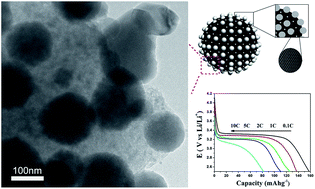Facile and economical synthesis for “plum pudding”-shaped porous LiFePO4/carbon composites for lithium ion batteries†
Abstract
A facile and economical template-free method has been developed to prepare “plum pudding”-shaped porous LiFePO4/C electrode materials for lithium ion batteries, which are synthesized by a one-step, dry ball milling with inexpensive Fe3+ salt as the raw material assisted by carbothermal reduction. Compared with a sample by ball milling with water, dry ball milling was beneficial to homogeneous nucleation of LiFePO4 in drying and subsequent thermal treatment processes. This material shows plentiful LiFePO4 nanospheres (∼200 nm) uniformly lodged in the 3D porous carbon architecture as an interconnected conductive framework due to the dry ball milling process. The dry-milling sample possessed nanoscale, active electrode materials (an average size distribution of ∼200 nm) with increased crystallinity, high surface area (up to 140 m2 g−1) and enhanced electronic conductivity contribute to improve the rate capability of the battery. The capacity of this “plum pudding”-shaped porous LiFePO4/C electrode materials achieved 157.4 mA h g−1 (92.6% of theoretical capacity) at the 0.1 C discharge rate and the practical charge capacity, 154.4 mA h g−1, has been achieved after 100 cycles.



 Please wait while we load your content...
Please wait while we load your content...